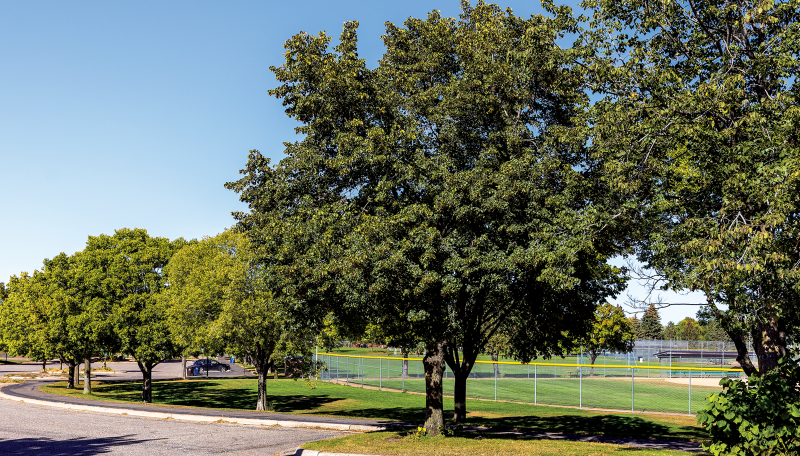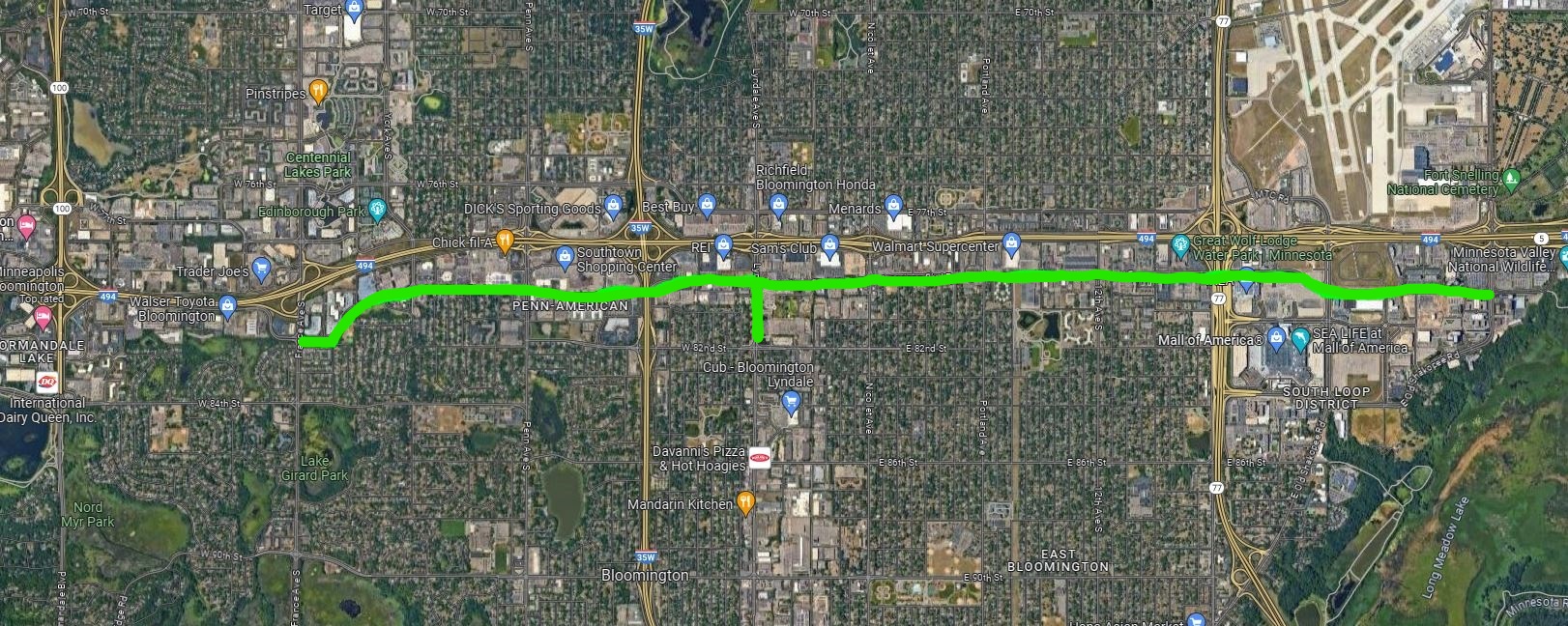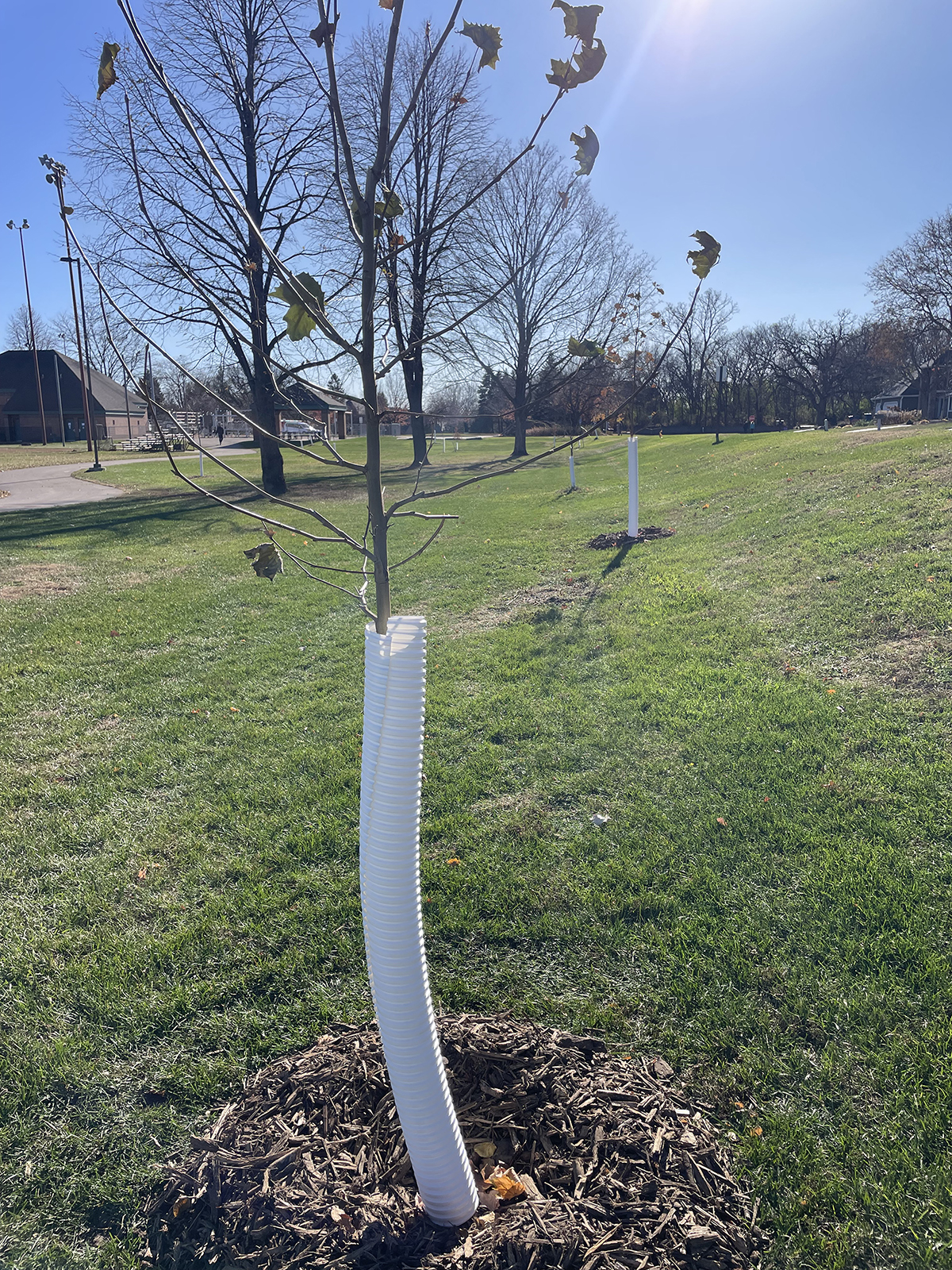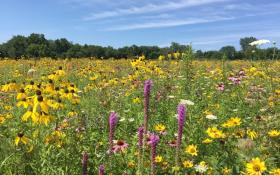Forestry
Parks and Recreation Links

The City of Bloomington continues to support the enhancement and preservation of our Community Forest both public and private. This is accomplished in a variety of ways including (but not limited to) the annual resident tree sale, aggressive tree health and tree disease management programs, and other programs and information provided throughout the year. Much of that information can be found on this web page.
In 2012, the National Arbor Day Foundation recognized Bloomington with the Tree City U.S.A. designation for the 31st consecutive year. This award is given to cities who show an ongoing and active commitment in support of community forestry programs.
Don't grow these trees in Bloomington
Per Section 18.03 of the City Code, it is unlawful to plant any of the following trees within the city:
- Ginkgo – maidenhair tree female only (Ginkgo biloba)
- Boxelder – also known as ash-leaved maple (Acer negundo)
- Eastern cottonwood (Populus deltoides)
- Lombardy poplar (Populus nigra italica)
- Buckthorn – common or European (Rhamnus Cathartica)
- Buckthorn – glossy, including all cultivars (Rhamnus Frangula)
- Ash – all species, varieties and cultivars (Fraxinus All)
FORESTRY ROLE AND RESPONSIBILITIES
Trimming
Street Maintenance crews trim boulevard trees that interfere with the operation of snowplows and street sweepers. This is done on a time available basis. Bloomington ordinance provides that the care and maintenance of boulevard trees is the responsibility of the abutting property owner. No permit is required for this care.
Tree health
In the boulevards, dead and dying trees with Emerald Ash Borer, Dutch elm disease, or oak wilt are removed under the City's Tree Disease Management program. Storm-damaged boulevard trees are trimmed or removed depending on the damage severity. Broken branches are removed to prevent damage to the street or walk when they fall. Stumps of removed trees are ground and the site is restored and seeded. No charge is made to the abutting property owner for these services.
Disease management
Bloomington has had a program to manage Dutch elm disease and oak wilt for over twenty-five years. In 2014, Emerald Ash Borer was added to the program. The City marks trees requiring removal. Property owners can choose to use a contractor hired by the City or handle the removal themselves. Every spring the contract is bid so the removal price can be given at the time of marking.
Signs of Dutch elm disease
Prompt diagnosis and removal of diseased trees are the keys to help control the spread of Dutch elm disease. Dead or dying elm trees can become a breeding ground for thousands of beetles that will move about and spread the disease.
Visible signs of Dutch elm disease include leaves on the upper branches that turn from green to yellow, curl, and become brown and brittle. These symptoms are common signs of a diseased tree and could signal Dutch elm disease. If more than a few branches are affected, then the entire tree must be removed. If only small portions of the tree show symptoms, quick and proper action might prolong the life of the tree.
Chemical fungicides are available that are designed to protect the tree, but there is no guarantee that a treated tree won't become infected with Dutch elm disease. Chemical treatments have a greater success rate with healthy trees.
Japanese Beetles
One of the most recent insect pests to deal with is the Japanese Beetles. Turf grass along with many different kinds of trees and shrubs can be attacked by these beetles with sometimes significant damage being done to both turf and landscape plants. The City recommends that residents visit the University of Minnesota Extension Division web page link below for clear and concise information on control methods and the timing of these controls. It must be remembered that control of this insect pest is possible but "eradication" is not possible and should not be our goal.
Oak and elm tree pruning advisory
Because of disease transmission (Emerald Ash Borer, Dutch Elm Disease, and Oak Wilt) these trees should be pruned when they are inactive. Therefore December, January and February are the best months to prune elms and oaks. This is also a good time to prune other shade trees.
Understand that these dates are not "set in concrete." Temperature and moisture can affect when trees should or shouldn't be pruned. The University of Minnesota has created the image to the right which will be updated to represent the current Oak Wilt risk level. You can also find more information at the University of Minnesota's web page by clicking the image or the link below:
Brush Disposal
Because Bloomington is within the Emerald Ash Borer (EAB) quarantine for Hennepin County it is important to know the rules for properly disposing of tree debris and brush. Details of the quarantine and other regulatory information can be found on the MN Department of Agriculture website.
Information regarding to disposal of tree waste, including logs and brush can be found on the MN Department of Agriculture website.
Because of disease transmission (Emerald Ash Borer, Dutch Elm Disease, and Oak Wilt) these trees should be pruned when they are inactive. Therefore December, January and February are the best months to prune elms and oaks. This is also a good time to prune other shade trees.
Understand that these dates are not "set in concrete." Temperature and moisture can affect when trees should or shouldn't be pruned. The University of Minnesota has created the image to the right which will be updated to represent the current Oak Wilt risk level. You can also find more information at the University of Minnesota's web page by clicking the image or the link below:
The land between residential property and adjacent ponds,wetlands, lakes and waterways is often owned by the City. In these areas, the City works to preserve native vegetation as a means of protecting environmental and water quality, and creating wildlife habitats. City land is held for the enjoyment of all residents and cannot be reserved for exclusive private use. It is the obligation of property owners to know their boundary lines so as not to disturb City property. The City Code prohibits the following in public areas:
- Damaging, cutting, carving, killing or injuring the bark of any tree or plant.
- Disturbing or mowing grass areas.
- Impairing its natural beauty or usefulness.
- Placement of playground or recreational equipment.
- Planting.
- Dumping lawn wastes or other refuse.
To preserve City property for the long-term benefit of all residents, the City will prosecute violations that are subject to misdemeanor penalties of up to $1,000 and 90 days in jail.

Don't let its size fool you: The Emerald Ash Borer represents an enormous threat.
The City has been fighting the Emerald Ash Borer since its discovery in November 2014. The iridescent green beetle’s larvae feed on the conductive tissues of ash tree bark, which eventually kills the tree.
Quarantine in effect
The Minnesota Department of Agriculture (MDA) has implemented a quarantine in multiple counties that prohibit the movement of the following items out of quarantined counties:
- Firewood from any hardwood (non-coniferous) species.
- Entire ash trees.
- Ash limbs and branches.
- Ash logs or untreated ash lumber with bark attached.
- Uncomposted ash chips and uncomposted ash bark chips larger than 2 inches in diameter.
Information regarding disposal of quarantined ash tree waste can be found on the MN Department of Agriculture website.
Seasonal information
The Minnesota Department of Agriculture indicates that the active period for the Emerald Ash Borer is May 1st through August 31st. Any pruning or removal of ash trees, branches or stumps should be avoided during this period as doing this may contribute to the spread of the Emerald Ash Borer disease. If ash tree work must be done for safety and hazardous condition reasons the material removed to include the outer 1 inch of the bark/ wood should be chipped on site or it should be transported in an enclosed vehicle to the nearest facility that can process the material. (only the outer 1 inch of bark/ wood harbors the EAB) A list of those approved disposal sites within the quarantine area are listed on the Minnesota Department of Agriculture web page. Pruning and removal of ash trees/ wood may be conducted from September 1st through April 30th.
Do I have Emerald Ash Borer? What does it look like?
The above picture offers a general idea of the Emerald Ash Borer's size and appearance.
Insecticide treatment information
Once EAB arrives in an area, it will remain a constant threat to ash trees for many years to come. If you choose to use an insecticide, it is likely that protective treatments will be needed for the rest of the tree's life. Optimal timing for most treatment methods is mid-April until the end of June.
- Emerald Ash Borer: Considerations for Homeowners before Selecting a Treatment Strategy
- Homeowner Guide to Insecticide Selection, Use, and Environmental Protection
City and State response
- MDA staff will conduct a thorough survey of trees in the surrounding area to assess the extent of infestation. Information from this survey will help determine the response strategy implemented by state and local officials. The MDA and MN DNR are working closely with the USDA Animal and Plant and Health Inspection Service in the MDA response.
- City staff tree inspectors licensed by MDA are prepared to include in our annual city tree inspections the search for EAB in both public and private areas in the City.
- The City's goal is to communicate the most current information available from the MDA, to encourage residents not to plant ash trees, to recommend residents take extra care of ash trees they are trying to retain, and assure residents our city tree inspection staff will be including the inspection for, and possible detection of, EAB as we do our annual inspections of trees in the city.
- We do not anticipate a major change in how the City deals with ash trees and EAB until such time as the MDA has completed its survey and makes a recommendation on how best to approach this new tree disease.
Help monitor for EAB in your neighborhood - Wasp Watchers Program information
Love trees? Want to help save them from invasive pests? You can be a volunteer citizen scientist and help survey your community for the presence of EAB. With the help of a harmless ground-nesting wasp (cerceris fumipennis) that hunts wood-boring beetles like EAB, we can monitor for the presence of these destructive invasive beetles. The female Cerceris wasps hunt for beetles in the trees and bring their prey back to their nest holes in the ground to feed to their offspring. An observer can easily watch a wasp colony and collect their beetle prey to check for EAB presence. Volunteering is easy and fun and really makes a difference for our wonderful Minnesota trees and forests. For more information, visit the Wasp Watchers website at waspwatchers.umn.edu.
To learn more visit z.umn.edu/waspwatchers.
Contact the Wasp Watchers Program Coordinator, Jennifer Schultz at 612-301-8310 or schultzj@umn.edu
Resources
PROJECTS
Open the tabs below to learn about the variety of projects the Forestry division of the Parks and Recreation Department undertakes to help preserve and improve the tree canopy in Bloomington.
In 2024 and 2025, the City worked with a contractor on the planting of more than 130 trees along a nearly 5-mile stretch of American Boulevard from Xerxes Ave. S. to 34th Ave S. The trees were planted in the right-of-way median and included:
- 23 Elm
- 22 Hackberry
- 23 Honey Locust
- 23 Kentucky Coffee
- 22 London Plane / Sycamore
- 23 Swamp White Oak
The entire initiative was funded by a Minnesota Department of Natural Resources Shade Tree Bonding Grant. Planting trees in this manner helps improve air quality and decreases the heat island effect. All species were selected for their hardiness and climate resilience.



In November 2025, the City hired a contractor to plant 30 new trees at Dred Scott Park. The new trees replaced 30 diseased trees that were recently removed.
Planting replacement trees in a 1-for-1 ratio helps maintain the proper ecological balance in the park keeping air quality stable and mitigating the heat island effect. All species were selected for their hardiness and climate resilience.
This initiative was funded by a Minnesota Department of Natural Resources Shade Tree Bonding Grant.


ANNUAL TREE SALE
Since 2008, the City's annual spring tree sale has offered residents a variety of tree species to plant in their yards and has added approximately 2,800 trees to Bloomington’s urban forest.
This program is among the initiatives that helps Bloomington maintain its Tree City USA status with the Arbor Day Foundation.
Residents may purchase a maximum of up to five trees per household and the trees are delivered in early May.
For complete details, visit the City Tree Sale page.
URBAN FOREST MASTER PLAN

The trees throughout Bloomington are an asset that bring value and benefits to the community. The City recognizes this asset and is working to ensure it continues bringing value and benefits to its residents for generations to come.
The urban forest provides environmental benefits, adds to property values and contributes to an enhanced quality of life for all Bloomington residents and visitors. Stressors such as invasive pests like EAB, diseases, the changing climate, air and water pollution, compacted soils, limited growing spaces and limited resources are all factors to consider when planning for the healthy growth of an urban forest.
Open the tabs below and visit Let's Talk Bloomington for more details on the Urban Forest Master Plan.
The Plan
Davey Resource Group is a nationally recognized leader in innovation, research and development of creative solutions for urban forestry. With this project they will conduct an operational assessment, review tree related ordinances/policy engage other staff, stakeholders and the community to develop an Urban Forest Master Plan to guide the future of Bloomington’s Forest canopy. The plan consists of four parts:
- Urban Tree Canopy Assessment utilizing GIS to map tree canopy, conduct analyses, and understand the extent and location of tree canopy.
- Right of Way Tree Inventory to locate, identify and assess an estimated 35,000 trees located within the public right-of-way.
- Urban Forest Master Plan document will be a shared vision through public engagement, merged with data collected during inventory and canopy analysis phases to develop a roadmap for the future management of Bloomington’s Urban Forest. Identify what strategies and level of service the public desires as it pertains to forestry operations.
- Treekeeper Canopy is a versatile software service that helps you observe, prioritize, and share your tree canopy assessment data. Users can interact with tree inventory and canopy assessment data in a variety of helpful ways. It can be used to coordinate work for City crews or outside contractors or sharing information with the public such as Eco-Benefits, Inventory, Urban Forestry Value and Canopy Coverage.
The Park System Master plan (PSMP) goals for natural resources are foundational to this project. Specifically: Develop an urban forest inventory to understand and increase the park system’s resiliency by diversifying the species composition.
The process will explore opportunities to advance our forestry operations to a higher level. Including an expanded program to increase canopy cover through boulevard tree planting. This project will help us target with greater accuracy and efficiency what neighborhoods are in the greatest need for reforestation projects, required resources, and an action plan to implement. Having a more current and comprehensive tree inventory along with an inclusive management plan will help us move into a more proactive Urban Forest regime.
Timeline
- Data collection, stakeholder and community engagement: To be completed by year end 2025
- Final plan: To be delivered first quarter of 2026
In addition to forestry initiatives, the City is actively engaged in a wide variety of natural area restoration work in parks and green spaces around Bloomington. Learn more on the Natural Resources page.

